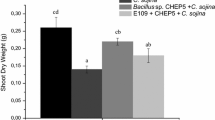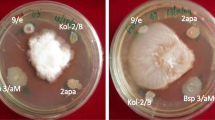Abstract
Plant-growth-promoting bacteria are often used to enhance crop yield and for biological control of phytopathogens. Bacillus sp. CHEP5 is a biocontrol agent that induces systemic resistance (ISR) in Arachis hypogaea L. (peanut) against Sclerotium rolfsii, the causal agent of root and stem wilt. In this work, the effect of the co-inoculation of Bacillus sp. CHEP5 and the peanut nodulating strain Bradyrhizobium sp. SEMIA 6144 was studied on induction of both systemic resistance and nodulation processes. Bradyrhizobium sp. SEMIA 6144 did not affect the ability of Bacillus sp. CHEP5 to protect peanut plants from S. rolfsii by ISR and the priming in challenged-plants, as evidenced by an increment in phenylalanine ammonia-lyase enzyme activity. Additionally, the capacity of Bradyrhizobium sp. SEMIA 6144 to induce nodule formation in pathogen-challenged plants was improved by the presence of Bacillus sp. CHEP5.



Similar content being viewed by others
References
Arnon DI 1949 Copper enzymes in isolated chloroplasts. Polyphenoloxidase in Beta vulgaris. Plant Physiol. 24 1–15
Badawi FSF, Biomy AMM and Desoky AH 2011 Peanut plant growth and yield as influenced by co-inoculation with Bradyrhizobium and some rhizo-microorganisms under sandy loam soil conditions. Ann. Agric. Sci. 56 1–9
Bradford M 1976 A rapid and sensitive method for the quantification of microgram quantities of protein utilizing the principle of protein dye binding. Anal. Biochem. 72 248–254
Brenner K, You L and Arnold FH 2008 Engineering microbial consortia: a new frontier in synthetic biology. Trends Biotechnol. 26 483–489
Bric JM, Bostock RM and Silverstone SE 1991 Rapid in situ assay for indolacetic acid production by bacteria immobilized on a nitrocellulose membrane. Appl. Environ. Microbiol. 5 535–538
Compant S, Duffy B, Nowak J, Clément C and Ait Barka E 2005 Minireview: Use of plant growth promoting bacteria for biocontrol of plant disease: principles, mechanisms of action and future prospects. Appl. Environ. Microbiol. 71 4951–4959
Conrath U, Beckers G, Flors V, García-Agustín P, Jakab G, Mauch F, Newman MA, Pieterse CMJ, Poinssot B, et al. 2006 Priming: getting ready for battle. Mol. Plant Microbe. Interact. 19 1062–1071
Fabra A, Castro S, Taurian T, Angelini J, Ibañez F, Dardanelli M, Tonelli ML, Bianucci E, et al. 2010 Interaction among Arachis hypogaea L. (peanut) and beneficial soil microorganisms: how much is it known? Crit. Rev. Microbiol. 36 179–194
Gordon SA and Weber RP 1951 Colorimetric estimation of indolacetic acid. Plant Physiol. 26 192–195
Grupta CP, Dubey RC and Maheshwari DK 2002 Plant growth enhancement and suppression of Macrophomina phaseolina causing charcoal rot of peanut by fluorescent Pseudomonas. Biol. Fertil. Soils 35 399–405
Heil M and Bostock R 2002 Induced systemic resistance (ISR) against pathogens in the context of induced plant defenses. Ann. Bot. 89 503–512
Hoagland DR and Arnon DI 1950 The water culture method for growing plants without soil. Calif. Agric. Exp. Stn. Circ. 347 1–39
Kloepper J, Tuzun S and Kúc J 1992 Proposed definitions related to induced disease resistance. Biocontrol. Sci. Technol. 2 349–351
Lugtenberg B and Kamilova F 2009 Plant-Growth-Promoting Rhizobacteria. Annu. Rev. Microbiol. 63 541–556
Madhaiyan M, Suresh Reddy BV, Anandham R, Senthilkumar M, Poonguzhali S, Sundaram SP and Sa T 2006 Plant-growth promoting Methylobacterium induces defence responses in groundnut (Arachis hypogaea L.) compared with rot pathogens. Curr. Microbiol. 53 270–276
Mc Kinney G 1938 Some absorption spectra of leaf extract. Plant Physiol. 13 128–140
Paré PW, Farag MA, Krishnamachari V, Zhang H, Ryu CM and Kloepper JW 2005 Elicitors and priming agents initiate plant defense responses. Photosynth. Res. 85 149–159
Paynet M, Martin C and Girand M 1971 Activité phenylalanine ammonia lyase et hypersensibilite au virus de la mosaique du tabac. Académie des Sciences, Paris 273 537–539
Pieterse C, Van Pelt J, Ton J, Parchmann S, Mueller M, Buchala A, Meâ Traux JP and Van Loon L 2000 Rhizobacteria-mediated induced systemic resistance (ISR) in Arabidopsis thaliana requires sensitivity to jasmonate and ethylene but is not accompanied by an increase in their production. Physiol. Mol. Plant Pathol. 57 123–134
Podile AR and Kishore K 2006 Plant growth-promoting rhizabacteria; in Plant-associated bacteria (ed) SS Gnanamanickam (Springer) pp 195–230
Podile AR and Laxmi VDV 1998 Seed bacterization with Bacillus subtilis AF 1 increases phenylalanine ammonia-lyase and reduces the incidence of fusarial wilt in Pigeonpea. J. Phytopathol. 146 255–259
Pozo MJ, Van Der Ent S, Van Loon LC and Pieterse CM 2008 Transcription factor MYC2 is involved in priming for enhanced defense during rhizobacteria-induced systemic resistance en Arabidopsis thaliana. New Phytol. 180 511–523
Reymond P and Farmer E 1998 Jasmonate and salicylate as global signals for defense gene expression. Curr. Opin. Plant Biol. 5 404–411
Somasegaran P and Hoben H 1994 Quantifying the growth of rhizobia; in Handbook for rhizobia: Methods in legume rhizobia technology (New York: Springer) Section 3, pp 382–390
Santos R, Herouart D, Sigaud S, Touati D and Puppo A 2001 Oxidative burst in alfalfa-Sinorhizobium meliloti symbiotic interaction. Mol. Plant-Microbe Interact. 14 86–89
Spaepen S, Vanderleyden J and Remans R 2007 Indole-3-acetic acid in microbial and microorganism-plant signaling. FEMS Microbiol. Rev. 31 425–448
Tonelli ML, Taurian T, Ibáñez F, Angelini J and Fabra A 2010 Selection and in vitro characterization of biocontrol agents to protect peanut plants against fungal pathogens. J. Plant Pathol. 92 73–82
Tonelli ML, Furlán A, Taurian T, Castro S and Fabra A 2011 Peanut priming induced by biocontrol agents. Physiol. Mol. Plant Pathol. 75 100–105
Tonelli ML, Ibañez F, Taurian T, Argüello J and Fabra A 2013 Analysis of a phenylalanine ammonia-lyase gene sequence from Arachis hypogaea L. and its transcript abundance in induced systemic resistance against Sclerotium rolfsii. J. Plant Pathol. 95 191–195
Van Loon LC, Bakker PHM and Pieterse JCM 1998 Systemic Resistance induced by rhizosphere bacteria. Annu. Rev. Phytopathol. 36 453–483
Van Loon L, Rep M and Pieterse C 2006 Significance of inducible defense-related proteins in infected plants. Annu. Rev. Phytopathol. 44 135–162
Verhagen BWM, Glazebrook J, Zhu T, Chang HS, Van Loon LC and Pieterse CMJ 2004 The transcriptome of rhizobacteria-induced systemic resistance in Arabidopsis. Mol. Plant Microbe. Interact. 17 895–908
Verma JP, Yadav J, Tiwari KN and Lavakush Singh V 2010 Impact of plant growth promoting rhizobacteria on crop production. Int. J. Agricul. Res. 5 954–983
Versalovic J, Schneider M, de Bruijn F and Lupski J 1994 Genomic fingerprint of bacteria using repetitive secuence based PCR (rep-PCR). Meth. Mol. Cell. Biol. 5 25–30
Vincent JM 1970 A manual for the practical study of root nodule bacteria; in International Biological Programme Handbook n° 15 (Oxford: Blackwell Scientific Publications Ltd.) pp 73–97
Zamioudis C and Pieterse CMJ 2012 Modulation of host immunity by beneficial microbes. MPMI 25 139–150
Acknowledgements
This study was financially supported by the SECyT-UNRC, CONICET, Ministerio de Ciencia y Tecnología de Córdoba, ANPCyT and Fundación Maní Argentino grants. The authors are grateful to Verónica L Muñoz, MA in Applied Linguistics, for editing the language aspects of the manuscript.
Author information
Authors and Affiliations
Corresponding author
Additional information
Corresponding editor: DURGADAS P KASBEKAR
MS received 04 March 2014; accepted 05 August 2014
Corresponding editor: Durgadas P Kasbekar
[Figueredo MS, Tonelli ML, Taurian T, Angelini J, Ibañez F, Valetti L, Muñoz V, Anzuay MS, Ludueña L and Fabra A 2014 Interrelationships between Bacillus sp. CHEP5 and Bradyrhizobium sp. SEMIA6144 in the induced systemic resistance against Sclerotium rolfsii and symbiosis on peanut plants. J. Biosci. 39 1–9] DOI 10.1007/s12038-014-9470-8
Rights and permissions
About this article
Cite this article
Figueredo, M.S., Tonelli, M.L., Taurian, T. et al. Interrelationships between Bacillus sp. CHEP5 and Bradyrhizobium sp. SEMIA6144 in the induced systemic resistance against Sclerotium rolfsii and symbiosis on peanut plants. J Biosci 39, 877–885 (2014). https://doi.org/10.1007/s12038-014-9470-8
Received:
Accepted:
Published:
Issue Date:
DOI: https://doi.org/10.1007/s12038-014-9470-8




